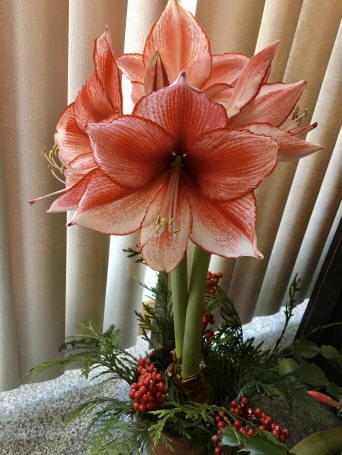 The genus Amaryllis comes from the Greek word amarysso, which means "to sparkle". Greek mythology brings us the story of Amaryllis, a love-struck maiden who longed for the handsome but cold-hearted Alteo. Desperate to win his love, she pierced her heart with a golden arrow and then visited his cottage daily, shedding drops of blood along the way. On the thirtieth day, beautiful scarlet flowers bloomed along the path. Alteo was enamored, Amaryllis’ heart was healed, and this lovely holiday bloom got its name.
The genus Amaryllis comes from the Greek word amarysso, which means "to sparkle". Greek mythology brings us the story of Amaryllis, a love-struck maiden who longed for the handsome but cold-hearted Alteo. Desperate to win his love, she pierced her heart with a golden arrow and then visited his cottage daily, shedding drops of blood along the way. On the thirtieth day, beautiful scarlet flowers bloomed along the path. Alteo was enamored, Amaryllis’ heart was healed, and this lovely holiday bloom got its name.
Amaryllis bulbs were brought to Europe from Africa in the 1700’s. Currently, the U.S. imports more than 10 million Amaryllis bulbs every year, mainly from Holland and South Africa. Amaryllis has become quite popular as a favorite Christmas flower. One look at the Amaryllis bloom will convince anyone that it is a showstopper. Amaryllis blooms range from 4 to 10 inches in size and can be either single or double in form. It is not unusual to have at least 3 flowers on stems per bulb. While the most popular colors are red and white, flowers may also be pink, salmon, apricot, rose, or deep burgundy. Some varieties are bicolor or picotee (flowers whose edge is a different color than the flower’s base color).
Amaryllis bulbs come in various sizes. Whether purchasing a bare bulb to plant or bulbs planted in a pot, the size and condition of bulbs will influence Amaryllis performance. Select the largest bulbs available for the desired plant variety. The larger the bulb, the more flowers it will produce. Inspect the bulb carefully. It should be firm and dry with no signs of mold, decay or injury. It is common to see new growth starting to emerge from bare or planted bulbs.
Plant each bulb in a 7- or 8-inch pot. Bulbs may also be clustered in a larger container. A terra cotta pot is a good choice because it helps to counterbalance the weight of the flowers. Use any potting mix that is available in garden centers. Plant the bulb so that the top one-third to one-half of the bulb is above the level of the potting mix. Water thoroughly after planting and then water sparingly until growth is clearly under way. Place the pot in a sunny window (south or west facing is best). Room temperature of 60 -70 degrees F. is ideal because the bulb will grow faster in a warm room. As the Amaryllis is maturing, water thoroughly whenever the surface of the potting mix is dry to the touch. Do not let the plant sit in water as wet soil can promote bulb and root rot and attract pests.
After the stem appears, it is important to turn the pot daily to promote balanced growth. If the pot is not turned, the stems will lean toward the window. In the average home, the flowers will appear 8-12 weeks after planting. When the Amaryllis has begun to bloom, the stunning bloom can be prolonged by moving the bulb to a cool location at night.
It is quite probable that you can get your Amaryllis to flower again the following winter. As the flowers on each stem fade, cut the stem off 2 inches above the top of the bulb. Do not cut the leaves. Continue to water as needed and begin fertilizing monthly with a water-soluble houseplant fertilizer with a high phosphorus content (mixed as directed). After the danger of frost has passed in the spring (around May 15), set the pot outdoors in a shady location. In a week or so, gradually increase the bulb’s exposure to sunlight. Ideally, the bulb needs 6 hours of sun a day to store up the energy it requires to flower. Continue to water and fertilize the bulb throughout the summer as you are caring for your other outdoor flowers.
In late summer or early fall (before the first frost) bring the pot indoors and place in a cool (50 degree) and dry location such as a basement for 6-8 weeks. Then place the Amaryllis in a sunny window and cut off any brown leaves. Begin the procedure for getting the Amaryllis to bloom in the winter.
An Amaryllis requires repotting every 3 or 4 years. The best time to repot it is after it has gone through a dormant period. Amaryllis is not susceptible to disease but inspect the plant regularly for spider mites and mealybugs, which can be treated with horticultural oil.
Few bulbs are easier to grow than Amaryllis, and few bulbs bloom with greater exuberance and beauty. An additional bonus is that they can be kept from year to year with a little timely care. When properly nurtured, an Amaryllis plant can live for 75 years! Amaryllis will richly reward the owner with beautiful and dramatically colorful blooms in the bleak mid- winter.